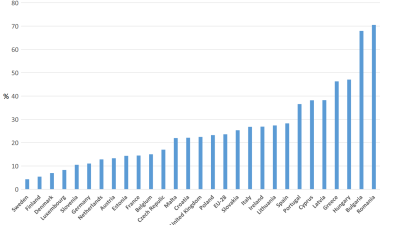Myths and misunderstandings fuel stereotypes that have a negative impact on people living in poverty in the UK, according to a series of essays published in New Statesman magazine. The authors seek to show how evidence and statistics have been 'misused, misrepresented and manipulated' to create propaganda for a 'war on welfare'.
Key ‘myths’ surrounding poverty
- 'There is no poverty in the UK'
Rys Farthing suggests, in her essay, that this myth arises because poor children are 'invisible in our class-ridden and aspirant society'. Some 3.6 million children currently grow up below the poverty line – a figure expected to reach 4.2 million by 2020. In total some 14 million people are at risk of poverty in the UK, while 37 per cent would be unable to cope with unexpected bills.
- 'Income is the only measure of poverty'
Christian Guy argues that measuring poverty by reference to income alone misses the root causes and hinders solutions to the problem. There is a need to take account of the full environment, from schooling to parenting to healthcare and everything else in between, to gain an accurate picture of poverty.
- 'Work gets people out of poverty'
Robert MacDonald and Tracy Shildrick highlight 'the low-pay, no-pay cycle', in which recurrent moves in and out of poverty are associated with recurrent moves in and out of low-paid, insecure employment.
- 'Economic growth at the top of society will solve poverty'
Deborah Hargreaves responds that the 'trickle down' theory is a real-life experiment that has failed. In the UK, the gap between top pay and average wages has been rising sharply since 1979, yet there has been no corresponding boom in investment. High earners have not invested their capital as predicted, but instead channelled it into financial assets and personal portfolios.
- 'Individuals can't make a difference to tackling poverty'
Mike Parker describes cases in which local people – individuals, groups and businesses – are finding ways to reduce poverty using their own skills, knowledge, resources and ingenuity.
- 'Scroungers live in mansions – paid for by the state'
Kate Henderson challenges the stigmas attached to social housing. A key function of social housing is to provide affordable accommodation to people on low incomes, often doing vital work in hospitals, on public transport and in nurseries. It also provides vital security to people who are disabled or unemployed. Social homes are often 'bolted on' to the edge of a town or city, where tenants have no say over their housing, lack security of tenure and suffer the stigma attached to such housing.
- 'We're all in this together'
Alison Garnham points out that whereas all those living in the bottom half of the income distribution will experience a net loss as a result of austerity measures, most of those in the upper income brackets will actually see net gains. The government has also made a deliberate choice to protect the value of old age pensions, leaving the cuts in social security to fall almost entirely on the working-age population.
Source: Becky Slack (ed.), Busting the Poverty Myths, Webb Memorial Trust in conjunction with New Statesman
Link: Essays



 PSE:UK is a major collaboration between the University of Bristol, Heriot-Watt University, The Open University, Queen's University Belfast, University of Glasgow and the University of York working with the National Centre for Social Research and the Northern Ireland Statistics and Research Agency. ESRC Grant RES-060-25-0052.
PSE:UK is a major collaboration between the University of Bristol, Heriot-Watt University, The Open University, Queen's University Belfast, University of Glasgow and the University of York working with the National Centre for Social Research and the Northern Ireland Statistics and Research Agency. ESRC Grant RES-060-25-0052.






